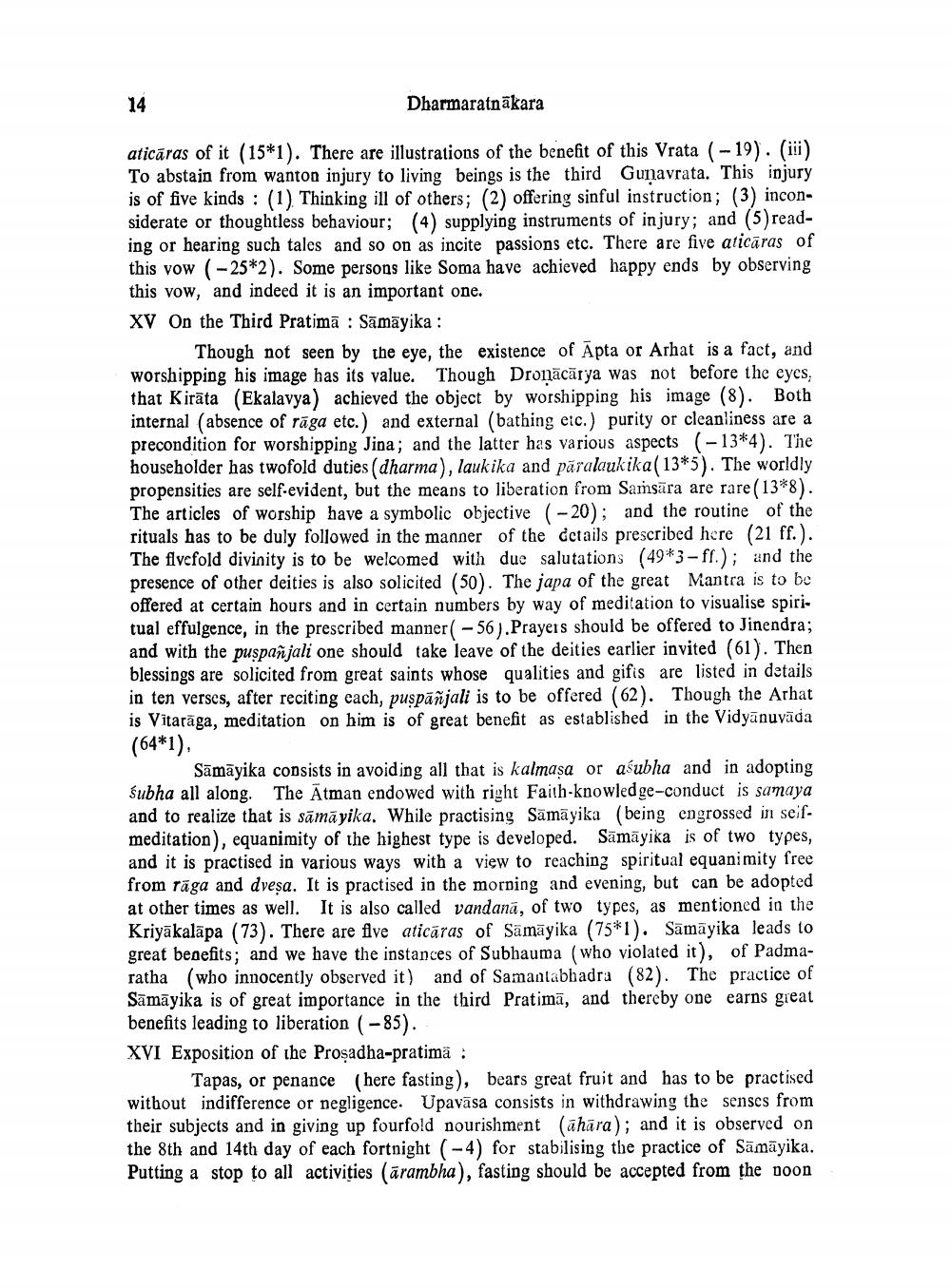________________
14
Dharmaratnākara
in pects (-13*4). The
ies are self-evident, bulunarma), laukika and pärale
aticāras of it (15*1). There are illustrations of the benefit of this Vrata (-19). (iii) To abstain from wanton injury to living beings is the third Gunavrata. This injury is of five kinds : (1) Thinking ill of others; (2) offering sinful instruction; (3) inconsiderate or thoughtless behaviour; (4) supplying instruments of injury; and (5) reading or hearing such tales and so on as incite passions etc. There are five aticāras of this vow (-25*2). Some persons like Soma have achieved happy ends by observing this vow, and indeed it is an important one. XV On the Third Pratimā : Sāmāyika :
Though not seen by the eye, the existence of Āpta or Arhat is a fact, and worshipping his image has its value. Though Dronācārya was not before the eyes, that Kirāta (Ekalavya) achieved the object by worshipping his image (8). Both internal (absence of rāga etc.) and external (bathing etc.) purity or cleanliness are a precondition for worshipping Jina; and the latter has various aspects (-13*4). The householder has twofold duties (dharma), laukika and pāralaukika(13*5). The worldly propensities are self-evident, but the means to liberation from Samsāra are rare (13*8). The articles of worship have a symbolic objective (-20); and the routine of the rituals has to be duly followed in the manner of the details prescribed here (21 ff.). The fivefold divinity is to be welcomed with due salutations (49*3 - ff.); and the presence of other deities is also solicited (50). The japa of the great Mantra is to be offered at certain hours and in certain numbers by way of meditation to visualise spiritual effulgence, in the prescribed manner( -56).Prayers should be offered to Jinendra; and with the puspañjali one should take leave of the deities earlier invited (61). Then blessings are solicited from great saints whose qualities and gifis are listed in details in ten verses, after reciting each, puspāñjali is to be offered (62). Though the Arhat is Vitarāga, meditation on him is of great benefit as established in the Vidyānuvāda (64*1),
Sāmāyika consists in avoiding all that is kalmasa or aśubha and in adopting śubha all along. The Ātman endowed with right Faith-knowledge-conduct is samaya and to realize that is sāmāyika. While practising Sāmāyika (being engrossed in seifmeditation), equanimity of the highest type is developed. Sāmāyika is of two types, and it is practised in various ways with a view to reaching spiritual equanimity free from rāga and dveşa. It is practised in the morning and evening, but can be adopted at other times as well. It is also called vandanā, of two types, as mentioned in the Kriyākalāpa (73). There are five aticāras of Sāmāyika (75*1). Sāmāyika leads to great benefits; and we have the instances of Subhauma (who violated it), of Padmaratha (who innocently observed it) and of Samantabbadra (82). The practice of Sāmāyika is of great importance in the third Pratimā, and thereby one earns great benefits leading to liberation (-85). XVI Exposition of the Proşadha-pratimä :
Tapas, or penance (here fasting), bears great fruit and has to be practised without indifference or negligence. Upavāsa consists in withdrawing the senses from their subjects and in giving up fourfold nourishment (āhāra); and it is observed on the 8th and 14th day of each fortnight (-4) for stabilising the practice of Sāmāyika. Putting a stop to all activities (ārambha), fasting should be accepted from the poon




